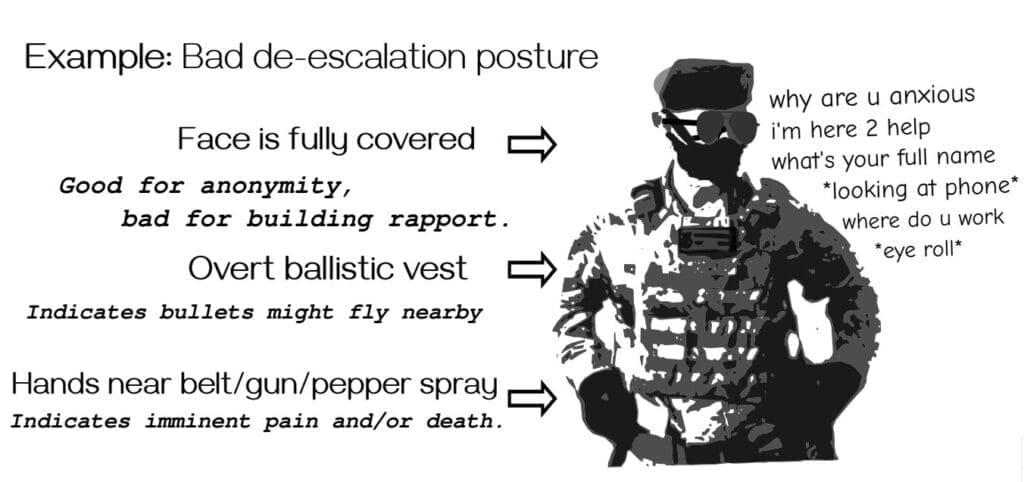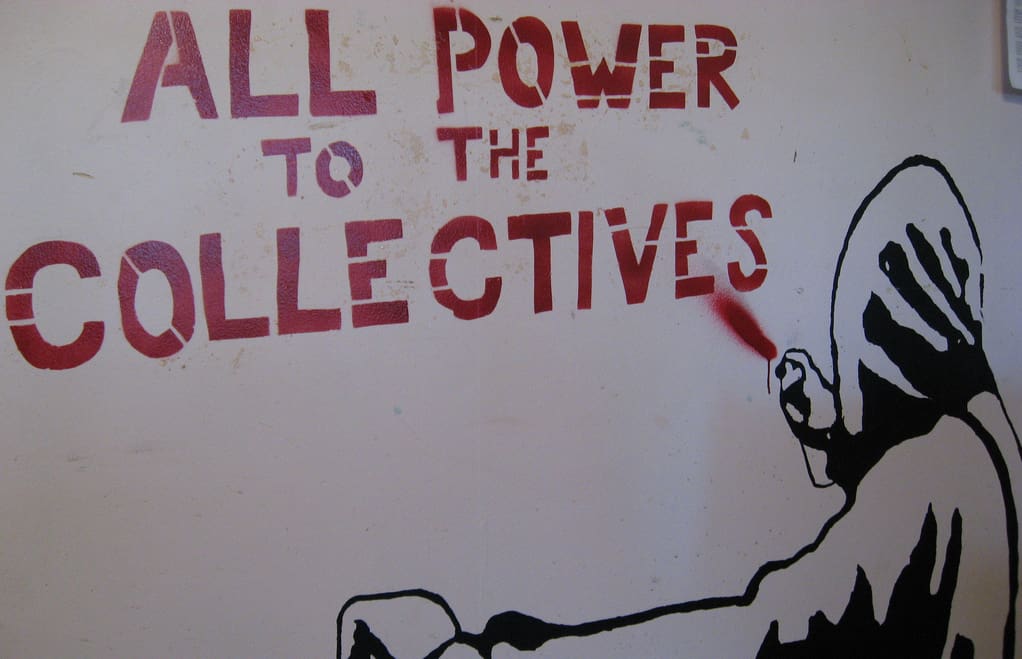AntiNote: The Puget Sound John Brown Gun Club produced a helpful instructional zine last year to assist organizers and participants in radical movements, actions, and spaces keep those spaces safe.
The theory and practice of movement and community defense has undergone rapid transformation in the last ten years and more. Accelerating during and after the onset of pandemic and global uprisings in 2020, new and refurbished approaches to topics like information and operational security, counter-surveillance, threat modeling, de-escalation techniques, physical self-defense, and weapons training have proliferated alongside a groundswell of interest in street medicine, grounded healing practice, and radical community care.
The following is just one small contribution to this growing wealth of knowledge-building material, but it is a good one, and concise. Its authors have encouraged its republication, and we have heeded their call in hopes that even just one download could be the difference between panic and calm in a future crisis, large or small.
Web and print formatted PDFs are linked at the top and bottom of this post. Please print, read, share, learn, teach! Help make “We Keep Us Safe” more than just a slogan.
De-escalation: Basic tips and techniques
by the Puget Sound John Brown Gun Club
PDF originals (read | print)
December 2023
De-escalation refers to the act of addressing escalated emotions that impair rational thinking. ‘Escalated emotions’ can mean any heightened emotional response which may affect decision making. Escalated emotions are neither positive nor negative; both a first date and a broken arm can cause them. An emotionally escalated person may behave in unreasonable and reckless ways. They can fail to realize they are in danger. De-escalation is often required before conflict resolution and problem solving can begin.
This document is adapted from a course on handling possible interactions at public demonstrations.
Caution: De-escalation can be dangerous.
You must approach danger with:
- Your full attention
- An abundance of caution
- An exit plan
There are situations which cannot be de-escalated. A person may have already made the decision to escalate before you speak to them. Some may escalate further upon your arrival. Have an exit plan and be ready to leave quickly. Compose yourself; aggression, belittling, and lecturing will never help your de-escalation effort. Avoid danger when alone; always work with a buddy. Carry cigarettes, snacks, and bottles of water; you cannot talk someone out of a craving, dehydration, or hunger.
Be aware of your emotions and body. Your heart rate, adrenaline, and blood pressure indicate when your emotions and instincts want to take control. You must first de-escalate yourself before you attempt to de-escalate others.
Opening Notes:
Dealing with escalated people is inherently uncomfortable and awkward. Feeling uncomfortable and awkward does not mean things are going poorly!
It may be tough to get a word in. They likely came to talk, not to listen. You must learn when to say something, when to listen, and when to monitor.
An escalated brain is not open to logic, debate, or decisions. We are more likely to succeed if we de-escalate with empathy, connection, and emotions. Our goal is to reduce tension, reduce agitation, and help the agitator get to a state where they can hear us when we present their options.
| Work as a buddy pair! It is easy to get tunnel vision while communicating intently during de-escalation. Listen for signals from your buddy and stay alert! |
Agitators don’t want to hear your opinions, they want you to hear theirs. To de-escalate: give them an audience of one. Help them feel heard and build trust. It gives us an opportunity to learn their motivations. We may also identify their needs and goals if they have any. Listen politely, repeat back what they say to confirm you’ve heard it correctly. Don’t affirm or attack, only acknowledge.
Example:
“What I am hearing is that you think ______, and because of that, you think everyone should _________. Is that accurate?”
Why is this useful?
- You let them know someone is listening.
- You begin a dialogue without endorsing their ideas.
- They now have a reason to listen to you.
- You are talking about something they care about (them).
- You are engaging their logical mind over their escalated mind.
An important benefit of this strategy: You are building trust without sharing information about yourself.
Respect Personal Space: Help them feel safe and able to focus.
Be aware of your position, posture, and proximity when interacting with a person in distress. Stay outside of striking distance. This keeps you safer and tends to decrease a person’s anxiety. The goal is to demonstrate that you are not a threat, that you respect them as a human, and that you are here to help. This cannot be communicated with words alone.
People behave rationally; when they are escalated their perception may not be accurate. Reduce distraction and “threat level” by respecting their space.

What are our goals when maintaining this distance?
- Enable them to focus on your words
- Demonstrate that your intent is not combative
- Minimize danger of physical injury
- Build trust that you are not there to escalate.
People have a hard time listening when they feel threatened. People are more perceptive of posture, tone, gaze, and hand movements when defensive senses are activated. They will be paying attention, you should too!
Nonverbal indicators can vary from culture to culture. In a very broad sense you want to communicate:
- You are listening
- You are not a threat
- You are not a target

Show you are engaged, alert, but not threatening. Keep hands visible with palms open and forward to demonstrate you are not holding a weapon. It is best to keep your hands around or below your chest. Avoid putting hands by your belt or inside your coat or pockets.
For extended discussions, try placing both hands over your heart. This leaves your arms in a position to react without looking aggressive.

Avoids “squaring up.” Keeps hands mostly visible while also keeping a hand up to protect the face and neck. Appears engaged and thoughtful but not passive.

Weight is distributed forward, ready to fight. Hands are fists, chest up, body is parallel with escalated person. This posture, especially within striking distance, tends to signal aggression. This is not recommended. Avoid squaring up: keep yourself at an angle relative to the escalated person. If you are close enough to strike them, you are probably too close for de-escalation.

Focus on Feelings
“Facts are important, but how a person feels is the heart of the matter. Yet some people have trouble identifying how they feel about what’s happening to them. Watch and listen carefully for the person’s real message. Try saying something like, ‘That must be scary.’ Supportive words like these will let the person know that you understand what’s happening, and you may get a positive response.”
– Crisis Prevention Institute’s “10 Tips.”
Focusing on feelings does not “solve” the issue at hand. It only helps people move forward to rationality. This brings us to a dilemma. It is unethical to use violence when de-escalation is an option; how do you ‘focus on feelings’ for people with abhorrent views and behavior? Or for people who hate us and wish us harm?
Luckily, there is a simple strategy for approaching this without requiring you to endorse or sympathize with their beliefs: try reflective paraphrasing.
“In the context that I was originally trained in, I was working with people experiencing mental health crises. It was a lot easier to respond to feelings with empathy. I will review strategies for de-escalating agitators, as well as folks in crisis. My number one strategy while de-escalating is using reflective paraphrasing: summarizing the feeling/experience that I am hearing in the words of the escalated individual. You can do this without agreeing with them.”
“It sounds like this has been a shocking experience. How are you feeling about it so far?“
“I just want to confirm I’m hearing you right: it seems like you’re pretty upset that traffic is blocked?“
“We’ve all experienced awkward silences. While it may seem counterintuitive to let moments of silence occur, sometimes it’s the best choice. It can give a person a chance to reflect on what’s happening, and how they need to proceed. Silence can be a powerful communication tool.”
– Crisis Prevention Institute’s “10 Tips.”
Silence is powerful! If you have nothing to say, and they have nothing to say, you are doing a great job! Let them breathe and diffuse.
Keep your emotional brain in check
“Remain calm, rational, and professional. While you can’t control the person’s behavior, how you respond to their behavior will have a direct effect on whether the situation escalates or defuses. Positive thoughts like ‘I can handle this’ and ‘I know what to do’ will help you maintain your own rationality and calm the person down.
– Crisis Prevention Institute’s “10 Tips.”
This takes practice! It’s okay to tap out or disengage. Have roles on your team and be clear. Verbalize your emotions to your team and buddy. If you feel like you can no longer engage: let your team know! Your buddy is there to help!
“I feel I can no longer de-escalate because I am getting overwhelmed.“
“Yo this guy is pissing me off, can we swap?“
Ignore Challenging Questions
“Engaging with people who ask challenging questions is rarely productive. When a person challenges you, redirect their attention to the issue at hand. Ignore the challenge, but not the person. Bring their focus back to how you can work together to solve the problem.”
– Crisis Prevention Institute’s “10 Tips.”
Some examples of challenging questions we might experience:
- Who are you to tell me what to do?
- Who’s paying you to do this?
It’s helpful to have some simple, truthful, and unthreatening stock responses handy.
“I just want to help people stay safe today.“
Feel free to ignore questions, especially if answering will escalate things.
Allow Time for Decisions
“When a person is upset, they may not be able to think clearly. Give them a few moments to think through what you’ve said. A person’s stress rises when they feel rushed. Allowing time brings calm.”
– Crisis Prevention Institute’s “10 Tips.”
A bad decision now? Or a good decision in twenty minutes? Give them time to process the situation. An escalated mind is not processing all the information around it. There is no wasted time with de-escalation. Let their brain catch up and make good choices.
Offer choices. Consider the “good choice sandwich” to engage their thinking brain and encourage logical actions: offer a positive choice, offer a negative choice, remind of positive choice.
Example for an escalated motorist:
“I can’t make the crowd vacate the intersection, so the options we have are: You can use the left lane to U-turn and go around this intersection, or you can wait here for fifteen minutes for the march to pass. Or, again, the other option is to make a U-turn and navigate around the block.“
Set Limits
“As a person progresses through a crisis, give them respectful, simple, and reasonable limits. Offer concise and respectful choices and consequences. A person who’s upset may not be able to focus on everything you say. Be clear, speak simply, and offer the positive choice first.”
– Crisis Prevention Institute’s “10 Tips.”
It’s important to maintain boundaries when you interact with an agitator. We build trust so that the options we present will be considered by a receptive and rational mind. Offer positive choice. Offer negative choice. Remind of positive choice. Set clear boundaries.
Further Reading:
“10 De-escalation Tips” by the Crisis Prevention Institute
Puget Sound John Brown Gun Club is an antifascist, anti-racist, pro-worker community defense organization.






